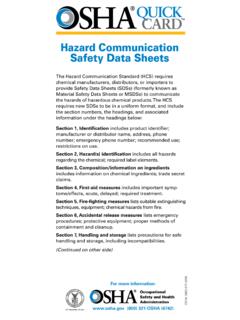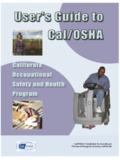Transcription of BRIEF - Occupational Safety and Health Administration
1 BRIEFOSHA has adopted new hazardous chemical labeling requirements as a part of its recent revision of the Hazard communication Standard, 29 CFR (HCS), bringing it into alignment with the United Nations Globally Harmonized System of Classification and Labelling of Chemicals (GHS). These changes will help ensure improved quality and consistency in the classification and labeling of all chemicals, and will also enhance worker comprehension. As a result, workers will have better information available on the safe handling and use of hazardous chemicals, thereby allowing them to avoid injuries and illnesses related to exposures to hazardous chemicals. The revised HCS changes the existing Hazard communication Standard (HCS/HazCom 19941) from a performance-based standard to one that has more structured requirements for the labeling of chemicals. The revised standard requires that information about chemical hazards be conveyed on labels using quick visual notations to alert the user, providing immediate recognition of the hazards .
2 Labels must also provide instructions on how to handle the chemical so that chemical users are informed about how to protect label provides information to the workers on the specific hazardous chemical. While labels provide important information for anyone who handles, uses, stores, and transports hazardous chemicals, they are limited by design in the amount of information they can provide. Safety Data Sheets (SDSs), which must accompany hazardous chemicals, are the more complete resource for details regarding hazardous chemicals. The revised 1 Prior to the 2012 update, the Hazard communication Standard had last been amended in 1994. HazCom 1994 refers to the version of the Hazard Communi-cation Standard in effect directly prior to the 2012 revision, printed in the 1995 through 2011 versions of the Code of Federal Regulations. It is also available on osha s communication Standard: Labels and Pictogramsstandard also requires the use of a 16-section Safety data sheet format, which provides detailed information regarding the chemical.
3 There is a separate osha BRIEF on SDSs that provides information on the new SDS hazardous chemicals shipped after June 1, 2015, must be labeled with specified elements including pictograms, signal words and hazard and precautionary statements. However, manufacturers, importers, and distributors may start using the new labeling system in the revised HCS before the June 1, 2015 effective date if they so choose. Until the June 1, 2015 effective date, manufacturers, importers and distributors may maintain compliance with the requirements of HazCom 1994 or the revised standard. Distributors may continue to ship containers labeled by manufacturers or importers (but not by the distributor themselves) in compliance with the HazCom 1994 until December 1, 2015. This document is designed to inform chemical receivers, chemical purchasers, and trainers about the label requirements.
4 It explains the new labeling elements, identifies what goes on a label, and describes what pictograms are and how to use RequirementsLabels, as defined in the HCS, are an appropriate group of written, printed or graphic informational elements concerning a hazardous chemical that are affixed to, printed on, or attached to the immediate container of a hazardous chemical, or to the outside HCS requires chemical manufacturers, importers, or distributors to ensure that each container of hazardous chemicals leaving the workplace is labeled, tagged or marked with the following information: product identifier; signal word; hazard statement(s); precautionary 12statement(s); and pictogram(s); and name, address and telephone number of the chemical manufacturer, importer, or other responsible par t develop labels under the revised HCS, manufacturers, importers and distributors must first identify and classify the chemical hazard(s).
5 Appendices A, B, and C are all mandatory. The classification criteria for Health hazards are in Appendix A and the criteria for physical hazards are presented in Appendix B of the revised Hazard communication Standard. After classifying the hazardous chemicals, the manufacturer, importer or distributor then consults Appendix C to determine the appropriate pictograms, signal words, and hazard and precautionary statement(s), for the chemical label. Once this information has been identified and gathered, then a label may be ElementsThe HCS now requires the following elements on labels of hazardous chemicals: Name, Address and Telephone Number of the chemical manufacturer, importer or other responsible party. Product Identifier is how the hazardous chemical is identified. This can be (but is not limited to) the chemical name, code number or batch number. The manufacturer, importer or distributor can decide the appropriate product identifier.
6 The same product identifier must be both on the label and in section 1 of the SDS. Signal Words are used to indicate the relative level of severity of the hazard and alert the reader to a potential hazard on the label. There are only two words used as signal words, Danger and Warning. Within a specific hazard class, Danger is used for the more severe hazards and Warning is used for the less severe hazards . There will only be one signal word on the label no matter how many hazards a chemical may have. If one of the hazards warrants a Danger signal word and another warrants the signal word Warning, then only Danger should appear on the label. Hazard Statements describe the nature of the hazard(s) of a chemical, including, where appropriate, the degree of hazard. For example: Causes damage to kidneys through prolonged or repeated exposure when absorbed through the skin.
7 All of the applicable hazard statements must appear on the label. Hazard statements may be combined where appropriate to reduce redundancies and improve readability. The hazard statements are specific to the hazard classification categories, and chemical users should always see the same statement for the same hazards no matter what the chemical is or who produces it. Precautionary Statements describe recommended measures that should be taken to minimize or prevent adverse effects resulting from exposure to the hazardous chemical or improper storage or handling. There are four types of precautionary statements: prevention (to minimize exposure); response (in case of accidental spillage or exposure emergency response, and first-aid); storage; and disposal. For example, a chemical presenting a specific target organ toxicity (repeated exposure) hazard would include the following on the label: Do not breathe dust/fume/gas/mist/vapors/spray.
8 Get medical advice/attention if you feel unwell. Dispose of contents/container in accordance with local/regional/ national and international regulations. A forward slash (/) designates that the classifier can choose one of the precautionary statements. In the example Labels for a hazardous chemical must contain: Name, Address and Telephone Number Product Identifier Signal Word Hazard Statement(s) Precautionary Statement(s) Pictogram(s)3above, the label could state, Do not breathe vapors or spray. Get medical attention if you feel unwell. Dispose of contents in accordance with local/regional/national/international regulations. See Examples 1 and 2A of this document as an example. In most cases, the precautionary statements are independent. However, osha does allow flexibility for applying precautionary statements to the label, such as combining statements, using an order of precedence or eliminating an inappropriate statement.
9 Precautionary statements may be combined on the label to save on space and improve readability. For example, Keep away from heat, spark and open flames, Store in a well-ventilated place, and Keep cool may be combined to read: Keep away from heat, sparks and open flames and store in a cool, well-ventilated place. Where a chemical is classified for a number of hazards and the precautionary statements are similar, the most stringent statements must be included on the label. In this case, the chemical manufacturer, importer, or distributor may impose an order of precedence where phrases concerning response require rapid action to ensure the Health and Safety of the exposed person. In the self-reactive hazard category Types C, D, E or F, three of the four precautionary statements for prevention are: Keep away from heat/sparks/open flame/hot surfaces.
10 - No Smoking. ; Keep/Store away from clothing/../ combustible materials ; Keep only in original container. These three precautionary statements could be combined to read: Keep in original container and away from heat, open flames, combustible materials and hot surfaces. - No Smoking. Finally, a manufacturer or importer may eliminate a precautionary statement if it can demonstrate that the statement is inappropriate. Supplementary Information. The label producer may provide additional instructions or information that it deems helpful. It may also list any hazards not otherwise classified under this portion of the label. This section must also identify the percentage of ingredient(s) of unknown acute toxicity when it is present in a concentration of 1% (and the classification is not based on testing the mixture as a whole). If an employer decides to include additional information regarding the chemical that is above and beyond what the standard requires, it may list this information under what is considered supplementary information.












